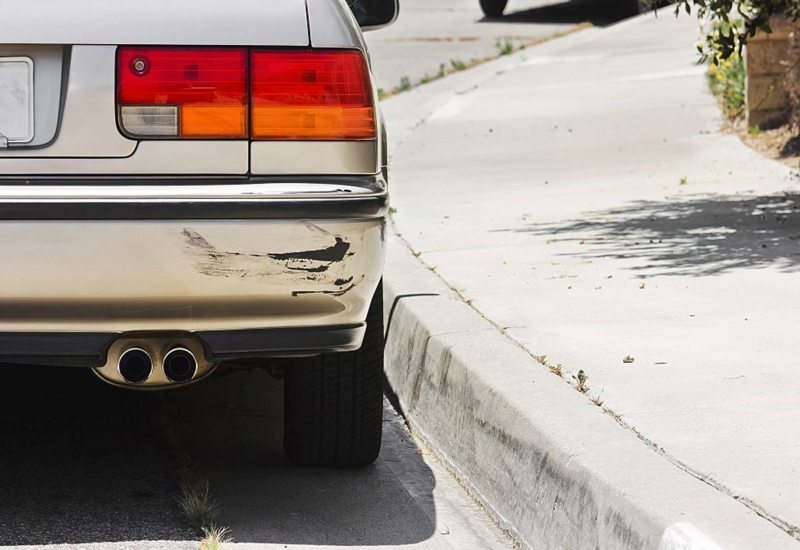
Accidentally backing into your garage door can be a distressing experience that not only disrupts your day but also poses a challenge in terms of damage assessment and repair. Such accidents can happen to anyone, whether due to a momentary distraction, a misjudgement of space, or a mechanical failure in the vehicle. Regardless of the cause, understanding the right steps to manage and resolve the situation is important. In this article we’ll provide a structured approach to dealing with the aftermath, helping you to mitigate any potential hazards, assess and address the damage, and ensure your garage door returns to full functionality with minimal disruption to your daily routine.
Step 1 – Stay Calm and Assess the Situation
When you realize you’ve backed into your garage door, the first reaction might be panic or frustration. It’s important to suppress these feelings, as calmness is important. After stopping the vehicle, take a moment to breathe deeply and assess your immediate safety. Make sure the car is in park and the engine is turned off to prevent any further accidents. Once you’ve ensured your personal safety, you can then focus on assessing the damage to the door.
Step 2 – Inspect the Damage
Get out of the vehicle and take a close look at the garage door. Note any visible signs of damage, such as dents, bends, or breaks in the door panels. Garage doors can be made from various materials, including steel, aluminum, wood, or fiberglass, and each material reacts differently to impact. For example, metal doors might have bent sections, while wooden doors could crack or splinter. Also inspect the mechanisms of the door, including the tracks, springs, and opener. Understanding the nature and extent of the damage will guide the subsequent steps.
Step 3 – Document the Damage
Before touching or attempting to fix anything, document the damage by taking photographs or videos with your phone. Capture various angles and details of the damage to both your vehicle and the garage door. These images will be valuable for insurance claims and for the repair professionals to understand what needs to be fixed. This documentation can also serve as a reference if there are any disputes or if you need to verify the completed repairs later.
Step 4 – Check the Door’s Operation
If the door appears structurally sound, carefully attempt to open and close it manually. This can help you determine whether the door’s basic functionality is intact or if the damage has impaired its operation. Avoid using automatic openers, as this could worsen the damage. If the door is difficult to move or won’t move at all, stop immediately to avoid further damage or personal injury.
Step 5 – Secure the Garage
If your garage door cannot be closed, it’s imperative to secure the garage, especially if you can’t get it repaired immediately. Use a tarp or plywood to cover exposed areas, securing those materials firmly to protect against weather elements and potential security risks. This temporary solution will work while you arrange for professional repair or replacement.
Step 6 – Contact a Professional
Contacting a professional garage door repair service is your next step. Look for a reputable garage door company with good reviews and appropriate credentials. A garage door professional can offer a comprehensive assessment and decide whether the door can be repaired or needs to be replaced. They can also make sure that repairs are done safely and efficiently, restoring the function and security of your garage door.
Step 7 – Review Your Insurance Coverage
Reach out to your insurance provider to find out if your policy covers damage to garage doors. Some homeowner’s insurance policies include coverage for such types of accidents, which could significantly reduce your out-of-pocket expenses. Understand your deductible and what aspects of the repair or replacement will be covered under your insurance plan.
Step 8 – Prevent Future Incidents
Once everything is sorted out, take preventive measures to avoid similar incidents in the future. Improve the lighting in your garage and driveway area to improve visibility. Consider installing parking aids like sensors or cameras that provide visual or auditory signals to prevent close calls. Reflect on the circumstances that led to the accident and see if any changes to your routine or setup could help you to avoid future issues.
Backing into your garage door can be an unexpected and unpleasant event, but with a structured approach, it can be managed effectively. By staying calm, assessing and documenting the damage, securing professional help, and contacting your insurance carrier, you can navigate through the situation with much less stress and uncertainty. Furthermore, implementing preventive measures could safeguard against future accidents, enhancing your garage door’s safety and functionality. Remember the key to dealing with such incidents lies in a prompt and organized response so that your garage remains a safe and fully operational part of your home.
Contact the Professionals
A1A Overhead Door, headquartered in Jacksonville, FL, excels in providing a full range of garage door services, including but not limited to installations, repairs, and maintenance. Renowned for our fast response to issues like broken springs and ensuring compliance with hurricane standards, our services blend security with modern design. Our family-owned business has as strong commitment to professionalism and the use of superior products, ensuring same-day service at competitive prices. Serving numerous counties across Florida and Georgia, we cater to both residential and commercial sectors promising complete customer satisfaction. For more information about the products and services we offer, contact us via our website or give us a call at 904-850-5094. We look forward to serving you!
- A1A Overhead Door Company11
- Energy Efficiency3
- Garage Door30
- Garage Door Installation13
- Garage Door Maintenance21
- Garage Door Openers15
- Garage Door Repair20
- Garage Door Safety38
- Garage Door Spring6
- Garage Door Springs5
- Garage Door Styles14
- Garage Doors10
- Garage Organization5
- Google+ Review1
- History of Garage Doors6
- Hurricane Code6
- Infographic2
- Insulation0
- Liftmaster0
- New Garage Door10
- Overhead Doors11
- Review0
- Wounded Warrior Project1
- Yelp Review0
